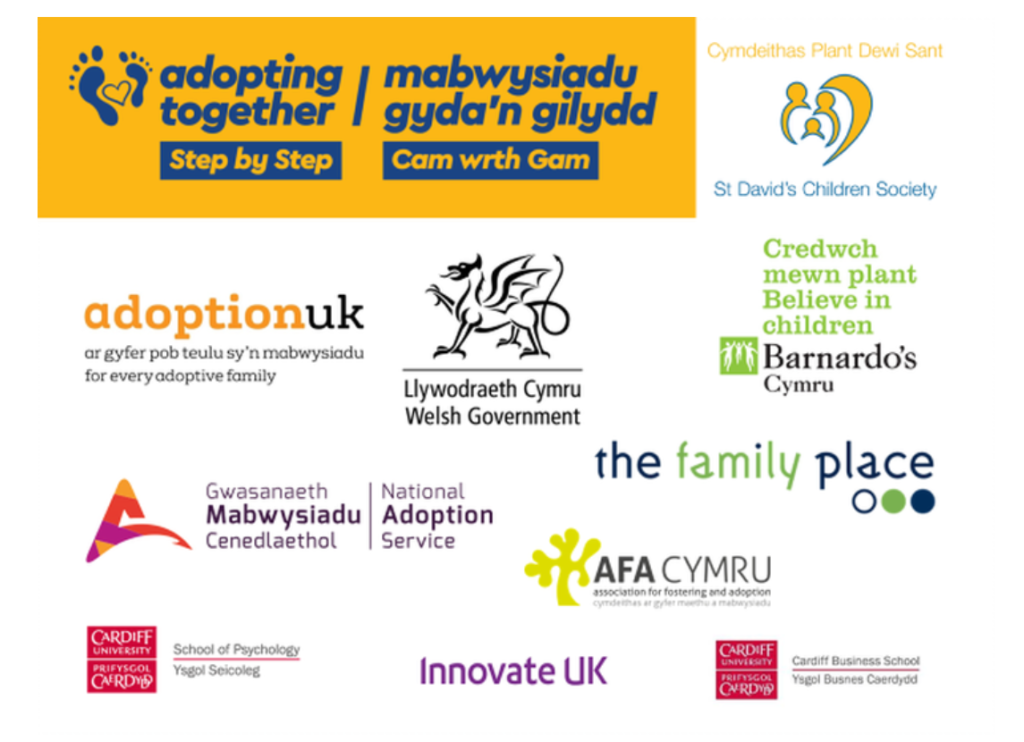On 9th October 2019, practitioners, service providers, representatives of the Welsh Assembly, foster carers and adoptive parents braved the rain, parking metres and forewent the Wales vs Fiji game to find out about the Adopting Together service at an Exchange event in Cardiff.
Adopting Together is an innovative, child-focused adoption service. It is being led by a partnership between St David’s Children Society and Barnardo’s Cymru, with both organisations recruiting and supporting families for children who have been waiting for their forever families for over 12 months. The project is unique in its fundamentally collaborative nature, with the agencies below all involved in some capacity:

Typically, the children who wait the longest for an adoptive family are children from BAME backgrounds, those who are placed for adoption with siblings and children who have disabilities, additional medical or emotional needs. The service was designed to hold these children in mind throughout the adoption process, with the voluntary sector identified as best placed to develop and deliver the Adopting Together service.
The Adoptive Together service has matched and placed 13 children since it started operating as a pilot in mid-2017. Wendy Keidan (Chief Executive of St David’s Children Society) and Singeta Kalhan-Gregory (service manager of Adopting Together) highlighted the four key components of Adopting Together, which incorporate extra levels of support and training at each stage of the adoption process:
Enhanced Training and Recruitment
- Child-specific recruitment (prospective adoptive parents are recruited for specific children currently within the Adopting Together service)
- Adopter-led ‘Child Profiling Events’ where prospective adoptive parents meet foster carers and social workers to find out about specific children
- Enhanced therapeutic training for prospective adoptive parents
Team for the Child Meeting
- Prior to matching
- Clinical psychology led
- Brings together the network around the child (the important adults in a child’s life – those who know them best, with a child’s foster carer being particularly important)
- Aims to produce a thorough understanding of a child and their needs (e.g. the impact of their early experiences, their psychological needs, but also what makes them happy or sad, what they like and dislike…)
Therapeutic Transitions
- Therapeutically trained social workers provide transitions sessions with the child, their foster carer and their adoptive parent(s) throughout the child’s move
- Transition sessions are play-based (using elements of Theraplay and DDP)
- Aim is to recognise the potential difficulty of the transition and to help the child develop a coherent narrative
Psychological Consultation Meetings
- Three meetings with a clinical psychologist once the child has moved in with their adoptive parents
- Enables parents to reflect on the experience of parenting their child and work through any difficulties that have arisen
- A core principle is that difficulties at this stage are anticipated and considered a normal part of the transition to family life
Adoption Manager Angela Harris and Family Finding Social Worker Katy Stamp gave a practitioners’ perspective on experiences of the service, from the Vale, Valleys and Cardiff Regional Collaborative, which they reported usually has over 100 children waiting for their forever family, a significant proportion of whom have waited six months or more. They welcomed the much-needed increased focus on the support needs of children, adoptive families and foster carers prior to, during and after a child’s transition from their foster family to their adoptive family, which Adopting Together is providing.
VVC had been the first Region to have their own Profiling Event, featuring twelve children, which Angela said had been a great success. She judged the child-specific training that adopters received through Adopting Together to be central to achieving its aims. Another crucial element was the opportunity for a child’s adopter and their foster carer to get to know one another and really work together to support the child. Angela explained that this process was facilitated by the Transitions Social Workers, and really gave the child ‘permission’ from their foster carer, the person they love and trust and who knows them better than anyone else, to move on to their new family life.
Katy had described one such foster carer, Leanne, as ‘the inspiration’ in her foster child’s life. Careful preparation through the Adopting Together Service had helped the child’s new adoptive parent to fully accept, and not feel rejected by, the child’s comments that the adopter was ‘not her favourite person’ – a role still occupied by Leanne. Leanne herself spoke powerfully about her experiences of supporting the child to move on to adoption, and how Adopting Together had given her the tools to support the little girl through the process of adoption. One year after the child’s move, Leanne was delighted to still have weekly contact. She noted that the openness of the process of Adopting Together had helped provide the best outcome for the child, as well as for herself and for the adopter.
Therapeutic social workers Judith Jones and Becky Couch talked about the transition work they are involved in as part of the Adopting Together Service. Transition sessions involve a series of games and stories that are fun for children, but also relational in nature and help with regulating emotions. For example, passing a dab of lotion around the circle or seeing who has the most warm or cold hands. The book ‘Not Again Little Owl’, about an owl who has lots of moves between different families, is often used. This forms the basis for recognising the big range of emotions, both good and bad, that children can experience through the transition to their adoptive family.
Judith and Becky talked about their experiences of transition work being that children tend to feel safer to say how they feel. For example: “I didn’t choose you – I don’t want to be here, I want to be back with my foster carer!”, with the idea that this is far more ‘real’ than a honeymoon period in the early days of adoption, where these things may be felt by children but not said. The repetition, play and stories introduced through the transition work aim to create containment and emotional safety for children, as well as for the network who surround them.
As Professor Katherine Shelton and Coralie Merchant from Cardiff University explained, the service is underpinned by an evidence base provided by the Schools of Psychology and Business at Cardiff. Data collected by the University demonstrate the service’s success. Adopters in the scheme were providing ‘exceptionally warm’ parenting, Professor Shelton commented.
Gareth, an adoptive Dad, made a plea for increased funding from the Assembly to support the expansion of the service, a view echoed by a second adoptive parent attending the workshop, who stated that Adopting Together should be the Gold Standard for all adoptions – not just for ‘harder to place’ children.
It’d be very hard to disagree.

